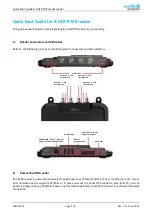
Rockwell Automation Publication 5069-UM003B-EN-P - January 2020
27
Compact 5000 I/O Serial Module Features
Chapter 3
Fault and Status Reporting
The Compact 5000 I/O serial modules report fault and status data along with
channel data. Fault and status data is reported in the following ways:
• Logix Designer application
• Module Status indicators
For more information on fault reporting, see the full chapter,
Module Inhibiting
Module inhibiting lets you indefinitely suspend a connection between an
owner-controller and a serial module without removing the module from the
configuration. This process lets you temporarily disable a module, such as to
perform maintenance.
You can use module inhibiting in the following ways:
• You write a configuration for an I/O module but inhibit the module to
help prevent it from communicating with the owner-controller. The owner
does not establish a connection and the configuration is not sent to the
module until the connection is uninhibited.
• In your application, a controller already owns a module, has downloaded
the configuration to the module, and is exchanging data over the
connection between the devices.
In this case, you can inhibit the module and the connection to the module
does not exist.
You can use module inhibiting in these instances:
• You want to update a serial I/O module, for example, update the module
firmware revision. Use the following procedure.
a. Inhibit the module.
b. Perform the update.
c. Uninhibit the module.
• You use a program that includes a module that you do not physically
possess yet. You do not want the controller to look for a module that does
not yet exist. In this case, you can inhibit the module in your program until
it physically resides in the proper slot.
















































